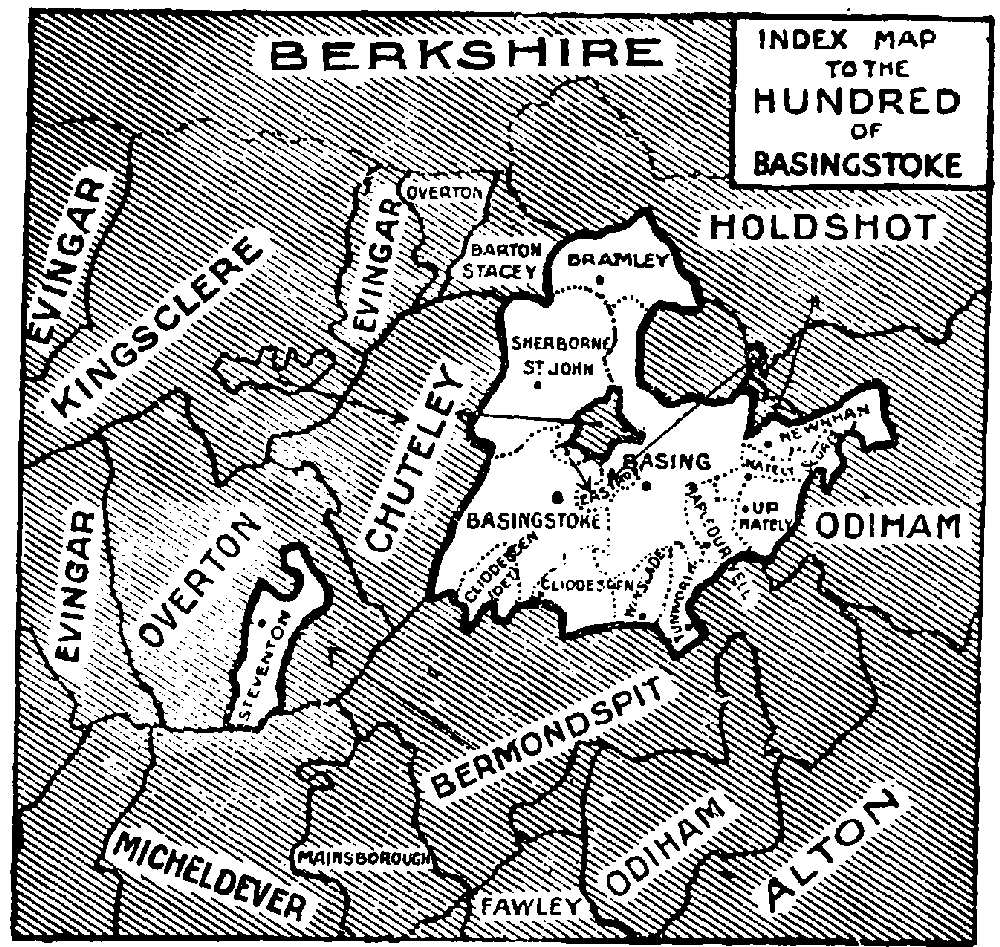A History of the County of Hampshire: Volume 4. Originally published by Victoria County History, London, 1911.
This free content was digitised by double rekeying. All rights reserved.
'The hundred of Basingstoke', in A History of the County of Hampshire: Volume 4, ed. William Page (London, 1911), British History Online https://prod.british-history.ac.uk/vch/hants/vol4/pp113-114 [accessed 23 April 2025].
'The hundred of Basingstoke', in A History of the County of Hampshire: Volume 4. Edited by William Page (London, 1911), British History Online, accessed April 23, 2025, https://prod.british-history.ac.uk/vch/hants/vol4/pp113-114.
"The hundred of Basingstoke". A History of the County of Hampshire: Volume 4. Ed. William Page (London, 1911), British History Online. Web. 23 April 2025. https://prod.british-history.ac.uk/vch/hants/vol4/pp113-114.
THE HUNDRED OF BASINGSTOKE
Containing the parishes of Basing; Basingstoke; Bramley; Cliddesden; Eastrop; Maplederwell; Nately Scures; Newnham; Sherborne St. John; Steventon; Tunworth; up Nately; Winslade; Kempshott Tithing
The above list represents the extent of the hundred in 1831. Between 1831 and 1841 various changes were made, Steventon being added to Overton Hundred, and Pamber, Sherfield-on-Loddon, Monk bherborne, Wootton St. Lawrence and Worting transferred to Basingstoke Hundred, the first from Barton Stacey Hundred, the second from Odiham Hundred and the other three from Chuteley Hundred.

Index Map to the Hundred of Basingstoke
At the time of the Domesday Survey the hundred comprised the same parishes as in 1831 with the addition of the tithing of Chineham in the parish of Monk Sherborne. (fn. 1) There were then 39½ hides in the hundred, as compared with 56 hides at the time of Edward the Confessor; Basingstoke being ancient demesne was not assessed. (fn. 2)
Henry III in 1228 granted the hundred with the manor to the men of Basingstoke at a rent of £72 12s. This grant appears to have continued in force till 1256, in which year the king issued another charter whereby he made the grant perpetual at a fee-farm rent of £80 a year. (fn. 3) From this date the hundred has followed the same descent as the manor.
An inquisition held in 1275 shows clearly that the hundred of Basingstoke comprised by this time also the tithings of Woodgarston in the parish of Monk Sherborne and Hazeley partly in Heckfield and partly in Hartley Wintney. (fn. 4) There is no mention, however, of Somershill, which was afterwards included in the hundred. (fn. 5)
A hundred court was held every third Saturday at Basingstoke. The court leet or view of frankpledge held twice a year at Basingstoke on the first Saturday after the Feast of St. Martin and the first Saturday after Hock-tide (fn. 6) was attended by tithingmen from Basing, Basingstoke, Bramley, Chineham, Cliddcsden, Eastrop, Hatch, Hazeley, Kempshott, Maplederwell, Nately Scures, Newnham, Sherborne St. John, Somershill, Steventon, Tunworth, Up Nately, Winslade and Woodgarston, (fn. 7) and cert-money was also paid by Basingstoke, Chineham, Cliddesden, Eastrop, Hatch, Hazeley, Kempshott, Nately Scures, Somershill, Steventon, Tunworth, Winslade and Woodgarston. (fn. 8) In 1831 Chineham was still reckoned in Basingstoke Hundred, although Hazeley and Woodgarston were returned under Heckfield in Holdshot and Monk Sherborne in Chuteley respectively. The name Somershill has now been lost.